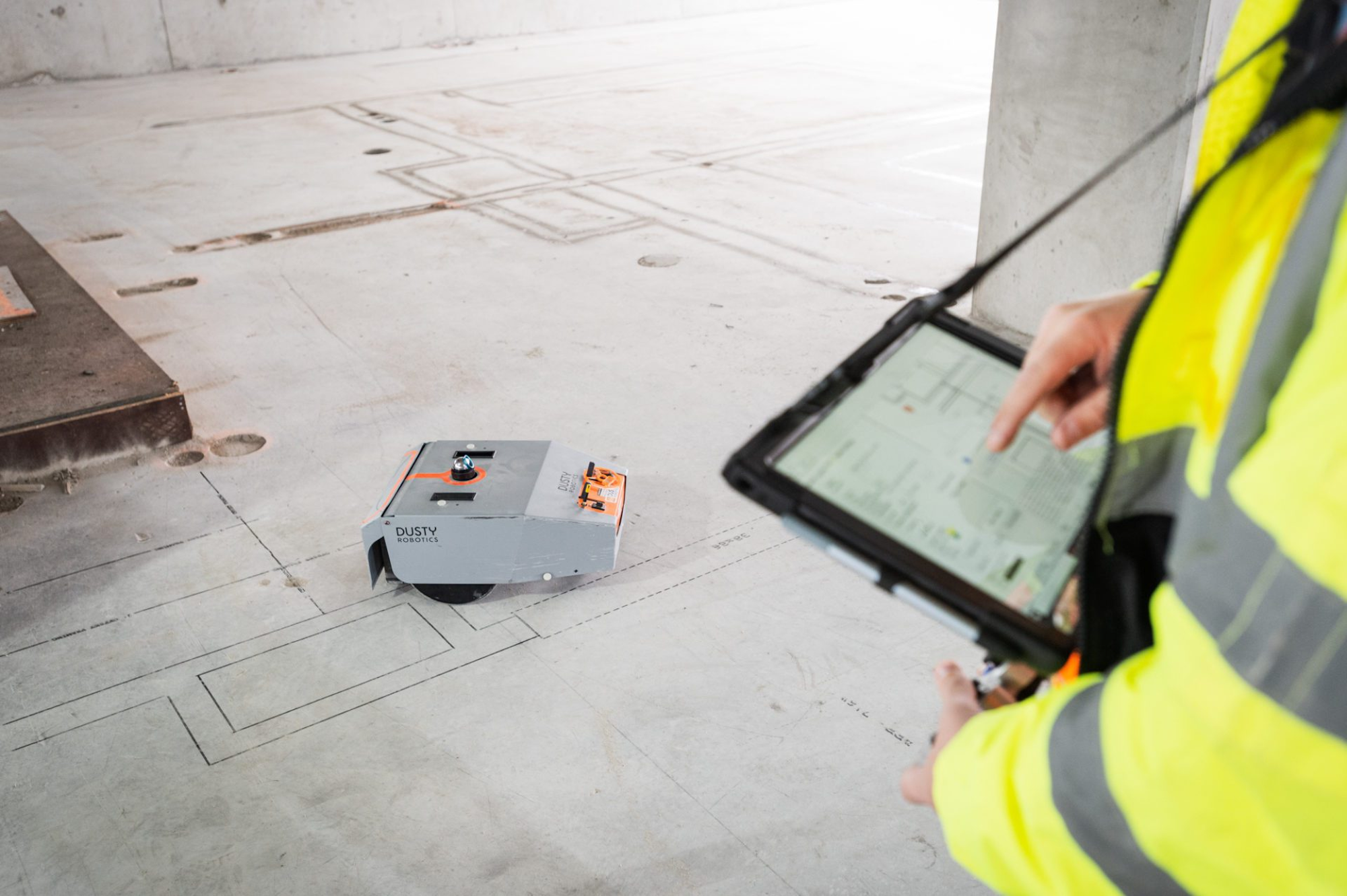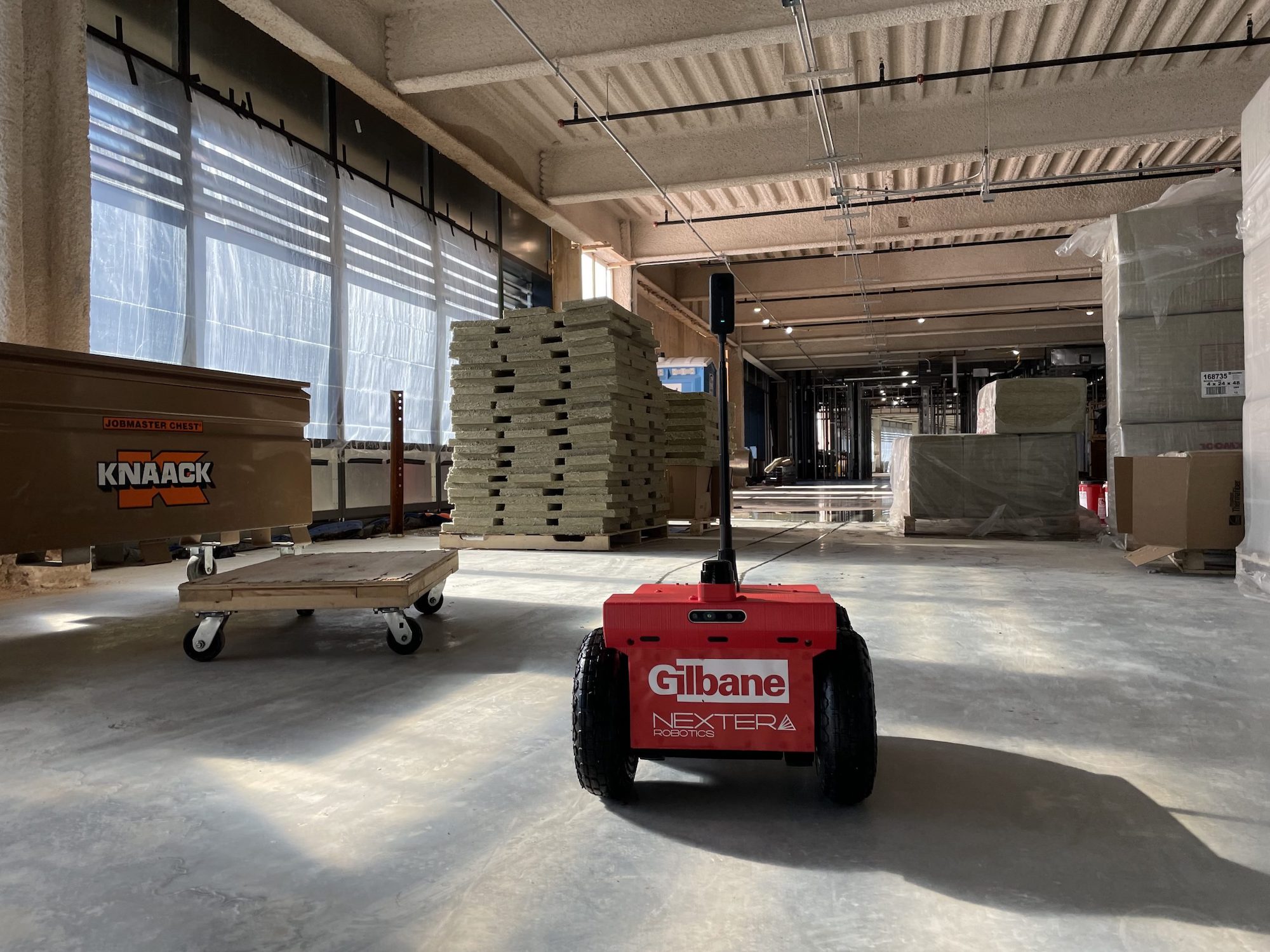In 2021, Gilbane Building Company and Nextera Robotics partnered in a joint venture to develop an artificial intelligence platform utilizing a fleet of autonomous mobile robots. The platform, dubbed Didge, is designed to automate construction management, maximize reliability and safety, and minimize operational costs.
This was just one of myriad examples over the past 18 months of contractor giants turning to construction technology (ConTech) to gather jobsite data, manage workers and equipment, and smooth the construction process.
Drones in particular have become standard tools for large and small contractors alike. These include Charleston, S.C.-based Brownstone, which increased its use of drones for site evaluations and inspections, and for quality control. Juneau Construction partnered with DroneDeploy to test and develop a 360 camera-based walkthrough platform for geolocated photo documentation of projects by any user.
Robotics took center stage at Swinerton, which last year became the first construction company with fully trained in-house operators for Dusty Robotics, and was an early adopter of that supplier’s FieldPrinter on projects in California, Texas, and Virginia. Turner Construction also has been using robotics for drywall finishing, perform layout, and overhead drilling. Turner recently tested Boston Dynamics’ Spot robot during an extensive multiyear pilot.
The growing impact of ConTech would be hard to overstate, with many contractors playing catch-up to level the playing field. Arc Building Partners expanded its use of tools like VDC and BIM, and hired its first VDC manager. Earlier this year, Truebeck Construction started using SLAM (for simulated localization and mapping) scanning, specifically NavVis VLX. Clark Contractors, in Little Rock, Ark., expanded its drone program (it now has five pilots), ventured into 3D scanning, and is now providing more digital documentation of construction drawings. DPR Construction partnered with a startup to refine a robot that handles layout for self-perform drywall crews, and sold the patent for that tool to Dusty Robotics. HITT Contracting invested in robotics by partnering with Clearpath Robotics to develop a semi-autonomous rover machine that provides an extra set of eyes and ears for superintendents on horizontal job sites. HITT also started using Boston Dynamics’ Spot and Hilti’s Jaibot for repetitive tasks such as drilling anchors.
ALSO SEE:
- 2022 Architecture Giants Trends Report: What’s new at 173 architecture firms
- 2022 Engineering Giants Trends Report: U.S. engineering firms cash in on a volatile, expanding market
Software is playing a much bigger role in contractors’ project management, too. Huitt-Zollars has implemented a companywide use of Bluebeam Revu for quality control on projects. Lendlease now makes extensive use of its Podium digital platform that offers a digital twin feature, can perform generative design, and includes Podium MX Studio, an automation and fabrication space for testing, prototyping, and assembling physical and digital components. Within the past year, Manhattan Construction has integrated Vista and ProjectSight software into its budgeting and cost data entry, Smart PM for scheduling analytics, and HammerTech for safety training.
CMR Partners teamed with Kahua, a project management information systems leader, to create an internal platform for CMR’s team to manage multi-jobsite programs and bring clients real-time data. As a result, CMR increased the efficiency of its document controls by 25%.
PCL Construction Enterprises internally developed a trademarked project management platform, called PM4+, as well as Job Site Insights, which uses sensors to monitor jobsite conditions like water intrusion or temperature. That real-time data, paired with artificial intelligence, has helped PCL become more predictive in its jobsite management and safety. Pepper Construction is using technology like SmartTagit and MindForge to improve communications with its tradespeople.
Pennsylvania-based W.S. Cumby’s implementation of tech and systems enhancements now includes TimberScan, which its project managers use to paperlessly approve general conditions charges; and portals in Procore through which subcontractors can submit digital invoices.
How construction firms are coping with COVID
ConTech provided contractors with solutions to manpower shortages and social-distancing restrictions during the COVID-19 pandemic. For its work on the expansion of New York’s John F. Kennedy International Airport’s Terminal 8, Holt Construction created “Get Ready to Work on Terminal 8,” a virtual program developed to identify, engage, and hire certified and local firms interested in workforce opportunities. Holt also developed “Opportunity Fridays,” a virtual program designed to host one-on-one meetings with the JFK T8 team. “We anticipate that this program will span all of our business units,” Holt stated. During COVID, JRM Construction’s jobsite management has included 360-degree virtual site walkthroughs for clients and a digital jobsite safety application for all workers, with touchless single-scan site check-ins.

Quite a few contractor giants cite jobsite safety among their recent accomplishments. In early 2021, Hill International developed a digital Job Hazard Analysis process tool that enables field employees to digitally access, complete, and submit forms to identify jobsite hazards before they occur. McCarthy Holdings’ Bright Idea platform, through which employees can share solutions for jobsite safety, in the past year impacted more than 125 projects across the country. McCarthy was also a founding member of the NEXT Coalition of industry peers that created a COVID Safety Challenge, and the firm adopted GoContractor, a digital onboarding and subcontractor management platform designed to reduce compliance risk and improve safety.
Robins & Morton has developed a virtual reality safety training app, which it released across the country last January. The firm’s safety team conducted training for 345 craft workers on 64 jobsites in 2021. Rogers O’Brien Construction’s Operational Excellence Program, launched in 2021, is “built on the foundation of safety,” said the firm, which also rolled out its Life Saving Commitments Program with the goal of eliminating serious injuries and fatalities through education, data review, and the firmwide integration of current safety practices.
To reduce falls that are the causes of so many construction-related injuries and deaths, Choate Construction created pedestal-mounted guardrail stanchions that can withstand more than 200 lbs. of weight and are designed to be reused from project to project. (AGC awarded Choate its Grand Award for its Willis Tower Watson 2022 National Construction Safety Excellence Awards.)
Managing volatility in the U.S. construction market
The recent supply chain disarray that has created worldwide product shortages, coupled with developer demands for quicker project completions, compelled more construction firms to explore different procurement and delivery methods. Fortis Construction, which specializes in mission-critical facilities, and W.M. Jordan Company refocused on prefabrication of building systems. Volumetric Building Companies (VBC) launched a proprietary modular solution called Volumetrix, a 10-step process for project delivery that encompasses design, logistics, production, and construction. In line with that launch, and to keep up with its “significant growth” over the past year, VBC expanded into components manufacturing via its August 2021 acquisition of a 577,000-sf factory in Tracy, Calif., that had previously been owned by Katerra.
To meet its construction workload, Hoar Construction needed a better way to stay on top of market volatility. It devised a Market Trends Dashboard for its internal teams to use via its intranet. The Dashboard provided monthly recaps, hard data, and insights that could be used for planning purposes. Similarly, Walbridge’s monthly Material Lead Time and Pricing Feedback Survey of its vendors and subcontractors provided Walbridge with reconnaissance for managing its supply chain and effectively measuring COVID’s impact.
Level 10 Construction deployed SpeedCore, a concrete-filled composite plate shear-wall system for core erection, on a project in San Jose, Calif., and reduced that project’s schedule by three months.
Like many other giants, Level 10 has been thriving: over the past decade, it has constructed 30 million sf of buildings and structures, and improved an additional 10 million sf of tenant space. That portfolio’s value is $9 billion.
The last few years have been robust for other firms, too. Findorff expanded more in 2021 than it had in its 132-year history. Last year, HITT Contracting delivered more than 1,400 projects in the U.S., and saw its revenue increase by 34%. Schimenti Construction added 100 core personnel and increased its employee count by 38 percent. Ryan Companies, which was active in every state last year, delivered an estimated 146 projects totaling more than 28 million sf.
ALSO SEE: BD+C's 2022 CONTRACTOR GIANTS RANKINGS:
Some of the contractors’ growth came from opening offices in new markets and adding new practices. Ann Arbor, Mich.-based PMA Consultants expanded into Canada by establishing operations in Toronto and Montreal. Fite Building Company invested in self-performing site work and developed a construction management services division within the company.
The aviation specialist VHR Construction developed its scanning services as a communications and collaboration tool. W.S. Cumby expanded its Philadelphia office to pursue religious building. PCL Construction’s solar practice grew its revenue by 40% in 2021, and increased its team to 214 people from 119. DeAngelis Diamond created a special projects division within its Naples, Fla., office, concentrating on interior renovations, additions, tenant improvements, and buildouts for commercial, faith-based, and nonprofit projects. In 2021, this division completed over 20 projects.
Striving for a fairer workplace in the construction sector
As contractors grew, they devoted more attention to workplace diversity, equity, and inclusion (DEI). Last year, Skanska’s leadership worked in partnership with the firm’s USA D&I Working Group to refine methods and metrics for recruitment, talent management, and education. The firm could also point to organic progress, such as the all-woman leadership team at its 9000 Wilshire office development in Los Angeles.
Shawmut Design and Construction launched a supplier diversity initiative, first regionally then nationally, to support Underrepresented Business Enterprises with topics such as insurance, bonding, and contract requirements. This task force focuses on increasing UBE partner outreach and participation, and setting diversity goals outside of client requirements.
In 2021, Robins & Morton introduced The Family Table, which celebrates diversity and inclusion and serving as a platform for team members to share individual perspectives. This year, Family Table is focusing on recruitment, training, career development, and information resources. Over the past year, STO Building Group has developed more robust Minority, Women, and Disadvantaged Business programs for subcontractors, achieved 40% supplier diversity on one of its projects, added more chapters to its STOBG Women in Construction network, and hired a DEI manager.







